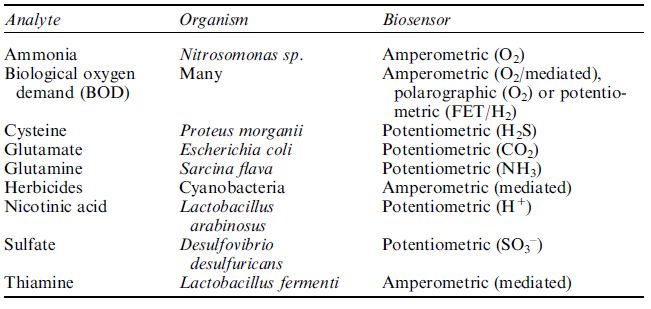


 النبات
النبات
 الحيوان
الحيوان
 الأحياء المجهرية
الأحياء المجهرية
 علم الأمراض
علم الأمراض
 التقانة الإحيائية
التقانة الإحيائية
 التقنية الحيوية المكروبية
التقنية الحيوية المكروبية
 التقنية الحياتية النانوية
التقنية الحياتية النانوية
 علم الأجنة
علم الأجنة
 الأحياء الجزيئي
الأحياء الجزيئي
 علم وظائف الأعضاء
علم وظائف الأعضاء
 الغدد
الغدد
 المضادات الحيوية
المضادات الحيوية|
Read More
Date: 15-1-2021
Date: 16-12-2020
Date: 22-12-2020
|
Whole Cell Biosensors
As biocatalysts, whole microbial cells can offer some advantages over pure enzymes when used in biosensors. Generally, microbial cells are cheaper, have longer active lifetimes and are less sensitive to inhibition,
pH and temperature variations than the isolated enzymes. Against these advantages, such devices usually offer longer response and recovery times, a lower selectivity and they are prone to biocatalytic leakage.
They are particularly useful where multistep or coenzyme-requiring reactions are necessary. The microbial cells may be viable or dead. The advantage of using viable cells is that the sensor may possess a selfrepair capability, but this must be balanced against the milder conditions necessary for use and problems that might occur due to membrane permeability and cellular outgrowth. Different types of whole cell biosensors are shown in Table 1.
Biochemical oxygen demand (BOD) biosensors most often use a single selected microbial species. Although rapid, linear and reproducible, they give a different result to conventional testing, which involve incubation over 5 days, and reflect the varying metabolism of a mixed microbial population. Thermophilic organisms have been used in such a biosensor for use in hot wastewater.
Table 1. Whole cell biosensors.




|
|
|
|
5 علامات تحذيرية قد تدل على "مشكل خطير" في الكبد
|
|
|
|
|
|
|
لحماية التراث الوطني.. العتبة العباسية تعلن عن ترميم أكثر من 200 وثيقة خلال عام 2024
|
|
|